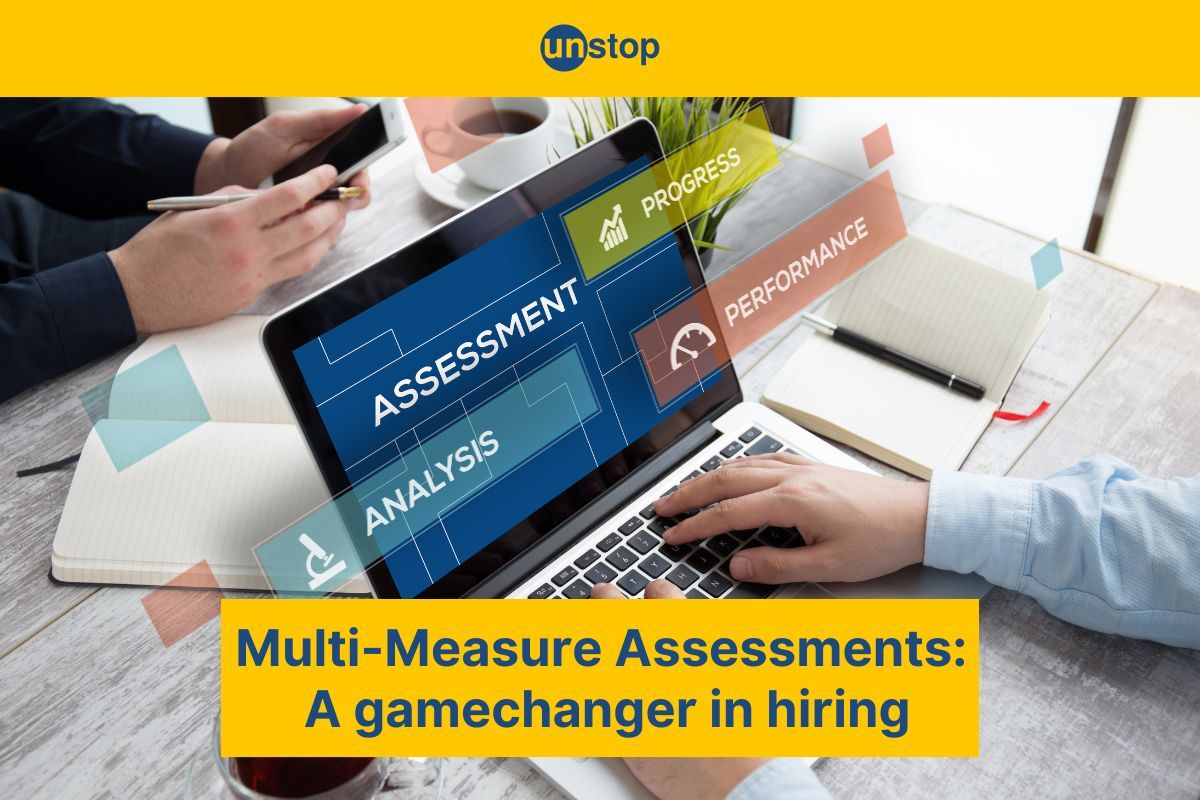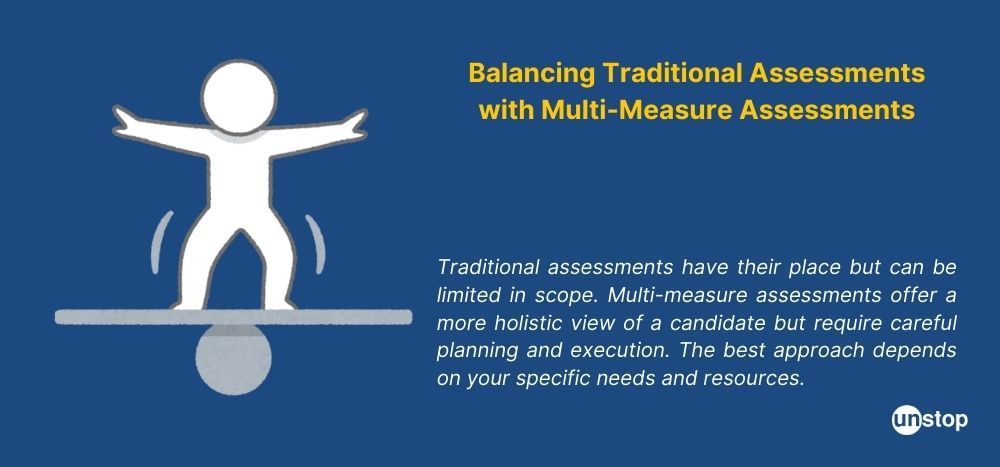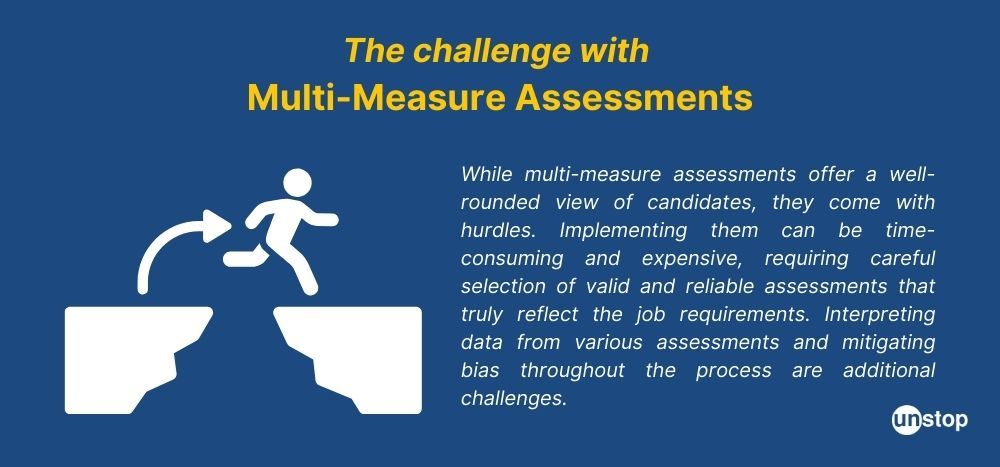- Understanding Multi-Measure Assessments
- Importance of Multi-Measure Assessment
- Challenges of Multi-Measure Assessments
- Mitigating Challenges of Multi-Measure Assessments
- Incorporating Multi-Measure Assessment in Hiring
- Final Remarks
- Frequently Asked Questions
Multi-Measure Assessments Can Improve Hiring Results. Here's How

When buying a product, you’re likely to look for product reviews online, compare prices from different sources, and even ask for feedback from anyone (in your social network) who has used the product. You use more than one measure to assess if the product is right for you. This is exactly what companies do by using multi-measure assessments in hiring.
In the realm of hiring, traditional assessments can be limiting. Multi-measure assessments help evaluate job candidates comprehensively, allowing employers to gain a more holistic view of a candidate's qualifications and potential fit for the role by utilising a combination of assessment methods such as skills tests, interviews, and case studies.
This method not only accommodates diverse candidate backgrounds and experiences but also provides deeper insights for making informed hiring decisions. Embracing multi-measure assessments in the hiring process can lead to a more inclusive and effective recruitment strategy, benefiting both employers and job seekers alike.
Understanding Multi-Measure Assessments
Definition
Multi-measure assessment is an approach to hiring that evaluates candidates using a combination of different assessment tools and methods. This approach provides a comprehensive view of a candidate's abilities, skills, and fit for a role.
These assessments measure cognitive abilities, personality traits, values, etc., to provide a comprehensive view of the candidate.
Multi-Measure Assessments vs Traditional Assessments
Here's a breakdown of the key differences between multi-measure assessments and traditional assessments in hiring:
| Feature | Traditional Assessments | Multi-Measure Assessments |
|---|---|---|
| Focus | Single method (resume, interview*, test) | Multiple methods combined |
| Strengths | Simpler, faster | More comprehensive, reduces bias |
| Weaknesses | Limited scope, susceptible to bias | Time-consuming, expensive |
| Example | Interview + Resume | Interview + Situational Judgment Test + Skills Test + Personality Assessment |
*Find pro tips on identifying and addressing interview fluff.


Importance of Multi-Measure Assessment
Holistic Evaluation
Traditional assessments often focus on singular aspects, such as skills or qualifications. In contrast, multi-measure assessments consider a broader range of factors, offering a more holistic view of candidates.
Each component of multi-measure assessments contributes unique data points that collectively paint a detailed picture of an individual's suitability for a role. By creating a comprehensive candidate profile through multi-measure assessments, recruiters can make well-informed hiring decisions.
These assessments enable recruiters to identify top talent accurately, leading to better hires and reducing turnover rates within organizations.
Enhanced Selection: Multi-measure assessments enable a comprehensive evaluation of candidates, considering competencies, interests, potential, and motives.
Organizational Performance
The use of multi-measure assessments plays a crucial role in enhancing the overall quality of hires. By assessing candidates from different angles, companies can match them effectively with roles they are best suited for.
Organizations implementing these assessments experience improved performance metrics and increased employee satisfaction levels, contributing to long-term success.
Predictive Power: The correlation between test scores and job performance provides insights into how well candidates may perform in the role.
Challenges of Multi-Measure Assessments

While multi-measure assessments offer advantages, they come with their own set of challenges. Here's a breakdown of some key hurdles to consider:
Cost and Time
- Implementation: Designing and implementing a multi-measure system can be more time-consuming and expensive compared to traditional methods. This includes selecting assessments, training staff on administration and scoring, and integrating them into the hiring process.
- Candidate Experience: Extensive assessments can extend the hiring timeline and potentially deter qualified candidates if they perceive the process to be too lengthy.
Assessment Selection and Quality
- Choosing the Right Tools: The effectiveness of multi-measure assessments hinges on selecting assessments that are well-suited to the specific job role. Generic tests might not provide valuable insights into a candidate's capabilities for a particular position.
- Validation and Reliability: It's crucial to choose assessments that are scientifically validated and reliable. Unreliable tests can lead to inaccurate data and biased hiring decisions.
Integration and Interpretation
- Combining Results: Integrating data from different assessments requires careful analysis and a clear scoring system to create a holistic picture of the candidate.
- Subjectivity: Some assessments, like personality tests, can involve subjective interpretations of results. Training and clear guidelines for interpreting the data are essential.
Additional Challenges
- Candidate Bias: While multi-measure can reduce bias compared to single methods, it's not foolproof. Careful design of the assessment process and training of those involved is crucial.
- Test Anxiety: Some candidates may experience anxiety during assessments, potentially affecting their performance. Offering practice tests or creating a relaxed testing environment can help mitigate this.
Multi-measure assessments can be a powerful tool for improving hiring decisions. However, acknowledging and addressing these challenges is crucial for successful implementation.
Mitigating Challenges of Multi-Measure Assessments
Here are some strategies to mitigate the challenges associated with multi-measure assessments in your hiring process:
Cost and Time
- Prioritize: Focus on incorporating assessments that target the most critical skills and behaviors for the role. This can help streamline the process and reduce time commitment for both candidates and recruiters.
- Standardize: Develop a standardized process for administering and scoring assessments. This saves time and ensures consistency.
- Technology Leverage: Utilize online assessment platforms to automate scheduling, delivery, and scoring of some assessments.
Assessment Selection and Quality
- Job Analysis: Conduct a thorough job analysis to identify the essential skills and knowledge required for success. Choose assessments that directly target these competencies.
- Professional Guidance: Partner with industrial-organizational psychologists or HR professionals with expertise in assessment selection and implementation.
- Research and Reviews: Research available assessments and read reviews from other companies before making a selection.
Integration and Interpretation
- Develop a Scoring Rubric: Create a clear scoring rubric that outlines how each assessment will be evaluated and how scores will be weighted in the final decision.
- Training for Evaluators: Train hiring managers and those involved in the process on interpreting and integrating assessment results.
- Focus on Behaviors: Use assessment results to identify candidates who demonstrate the desired behaviors for the position, not just raw scores.
Additional Challenges
- Bias Mitigation: Implement strategies to minimize bias throughout the hiring process. This can include using standardized interview questions, diverse interview panels, and blind scoring of assessments where applicable.
- Test Anxiety Reduction: Offer practice tests (if appropriate) or create a relaxed testing environment with clear instructions to help candidates feel comfortable during assessments.
- Continuous Evaluation: Monitor the effectiveness of your multi-measure approach. Regularly review assessment data and candidate feedback to identify areas for improvement and maintain a fair and efficient system.
By implementing these strategies, you can mitigate the challenges associated with multi-measure assessments and reap the benefits of a more comprehensive and data-driven hiring process. Remember, the key is to be strategic, invest in quality assessments, and prioritize a fair and consistent approach throughout the process.
Incorporating Multi-Measure Assessment in Hiring
Here are the steps to include multi-measure assessments in your hiring process:
Define Your Needs and Goals
- Identify the job role: Start by clearly defining the specific role you're hiring for and the essential skills, knowledge, and behaviors required for success.
- Set goals for your assessments: What aspects of the candidate do you want to assess beyond the resume and interview? Is it soft skills, problem-solving abilities, or specific technical skills?
Know the importance of soft skills in modern hiring.
Choose the Right Assessments
-
Research different types of assessments: There are various types of multi-measure assessments available, including:
- Work simulations: Replicate real-world job tasks and assess skills in action.
- Situational judgment tests (SJTs): Present hypothetical job scenarios and assess how candidates would make decisions.
- Personality assessments: Evaluate personality traits relevant to the job and team dynamics.
- Cognitive ability tests: Measure problem-solving, critical thinking, and learning ability.
- Skills tests: Assess specific job-related skills like coding, writing, or data analysis.
- Select assessments based on your goals: Choose assessments that target the specific skills and behaviors you identified in step 1.
- Consider validation and reliability: Ensure the assessments you choose are scientifically validated and reliable for predicting job performance.
Integrate Assessments into Your Hiring Process
- Develop a clear timeline: Decide at what stage of the hiring process you will administer the assessments.
- Candidate communication: Inform candidates about the assessments in advance and explain their purpose.
- Standardization: Implement a consistent process for administering and scoring the assessments.
- Integration with interviews: Use the assessment results to guide your interview questions and discussions.
Evaluate and Refine
- Track results: Monitor how well the multi-measure approach helps you select successful candidates.
- Gather feedback: Solicit feedback from candidates and hiring managers on their experience with the assessments.
- Refine your approach: Based on the results and feedback, modify your choices of assessments or how you implement them in the future.
Additional Tips
- Focus on job relevance: Ensure all assessments are directly relevant to the job requirements and avoid generic tests.
- Candidate experience: Make the assessment process user-friendly and respectful of candidates' time.
- Legal compliance: Ensure your assessments comply with anti-discrimination laws and regulations.
By following these steps and considering the additional tips, you can effectively incorporate multi-measure assessments into your hiring process and improve your chances of selecting the best candidates for your company.
Final Remarks
In conclusion, incorporating multi-measure assessments in the hiring process is crucial for recruiters to make informed decisions about potential candidates. By utilizing a variety of assessment methods, recruiters can gain a comprehensive understanding of a candidate's skills, abilities, and fit for the role.
It is important for recruiters to tailor assessment strategies to meet the specific needs of each candidate, leveraging technology for efficient data collection and analysis. Embracing multi-measure assessments allows recruiters to support the growth and success of their organization by hiring the best-fit candidates.
Staying proactive in exploring innovative assessment practices will ultimately lead to improved hiring outcomes and a more effective recruitment process.
Frequently Asked Questions
1. What is a multi-measure assessment?
A multi-measure assessment involves using various tools and methods to evaluate candidates. These can include cognitive tests, personality assessments, work samples, structured interviews, and more. The goal is to obtain a holistic view of a candidate’s capabilities and potential fit for the job.
2. Why use multi-measure assessments in hiring?
Multi-measure assessments provide a more complete picture of a candidate by evaluating different aspects of their skills, personality, and performance. This approach can help reduce biases, improve predictive validity, and increase the chances of hiring the right candidate.
3. What types of assessments are typically included in a multi-measure approach?
Common types of assessments include:
- Cognitive ability tests: Evaluate problem-solving, reasoning, and critical thinking skills.
- Personality tests: Assess traits that predict job performance and cultural fit.
- Skills tests: Measure specific job-related skills or competencies.
- Work samples: Provide a practical demonstration of the candidate’s abilities.
- Structured interviews: Standardized questions to assess qualifications and fit.
- Situational judgment tests: Assess decision-making and problem-solving in job-related scenarios.
4. How do multi-measure assessments improve hiring decisions?
By using multiple measures, employers can gather diverse data points about each candidate. This reduces the risk of relying on a single assessment that might not fully capture a candidate’s potential. It also helps identify strengths and weaknesses in different areas, leading to more informed hiring decisions.
5. How are multi-measure assessments administered?
Assessments can be administered online or in person. Online platforms allow candidates to complete assessments remotely, while in-person assessments can be conducted during interviews or assessment centers. The administration method depends on the types of assessments and the employer’s resources.
6. Are multi-measure assessments fair and unbiased?
When designed and implemented correctly, multi-measure assessments can reduce bias by providing objective data on candidates. It’s important to ensure that assessments are validated, reliable, and relevant to the job. Regularly reviewing and updating assessments can also help maintain fairness.
7. How do employers decide which assessments to include?
Employers should choose assessments based on the specific requirements of the job and the competencies needed for success. Job analysis and consultation with experts can help identify the most relevant and predictive assessments for a particular role.
8. What are the challenges of using multi-measure assessments?
Challenges include the time and cost of developing and administering multiple assessments, ensuring candidate engagement, and maintaining the validity and reliability of the assessments. Employers must also be mindful of data privacy and compliance with relevant laws and regulations.
9. How do candidates perceive multi-measure assessments?
Candidates generally perceive multi-measure assessments as more fair and comprehensive compared to single-method evaluations. Clear communication about the process and the purpose of each assessment can help enhance the candidate experience.
10. What are the best practices for implementing multi-measure assessments?
Best practices include:
- Conducting a thorough job analysis to identify key competencies.
- Selecting validated and reliable assessment tools.
- Ensuring the relevance of assessments to the job role.
- Providing clear instructions and support to candidates.
- Regularly reviewing and updating assessments.
- Training assessors to interpret results accurately and fairly.
Suggested Reads
I’m a reader first and a writer second, constantly diving into the world of content. If I’m not writing or reading, I like watching movies and dreaming of a life by the beach.
Login to continue reading
And access exclusive content, personalized recommendations, and career-boosting opportunities.
Subscribe
to our newsletter
Blogs you need to hog!

Organize Hackathons: The Ultimate Playbook With Past Case Studies

What is Campus Recruitment? How To Tap The Untapped Talent?

Lateral Hiring: A Complete Guide To The Process, Its Benefits, Challenges & Best Practices













Comments
Add comment